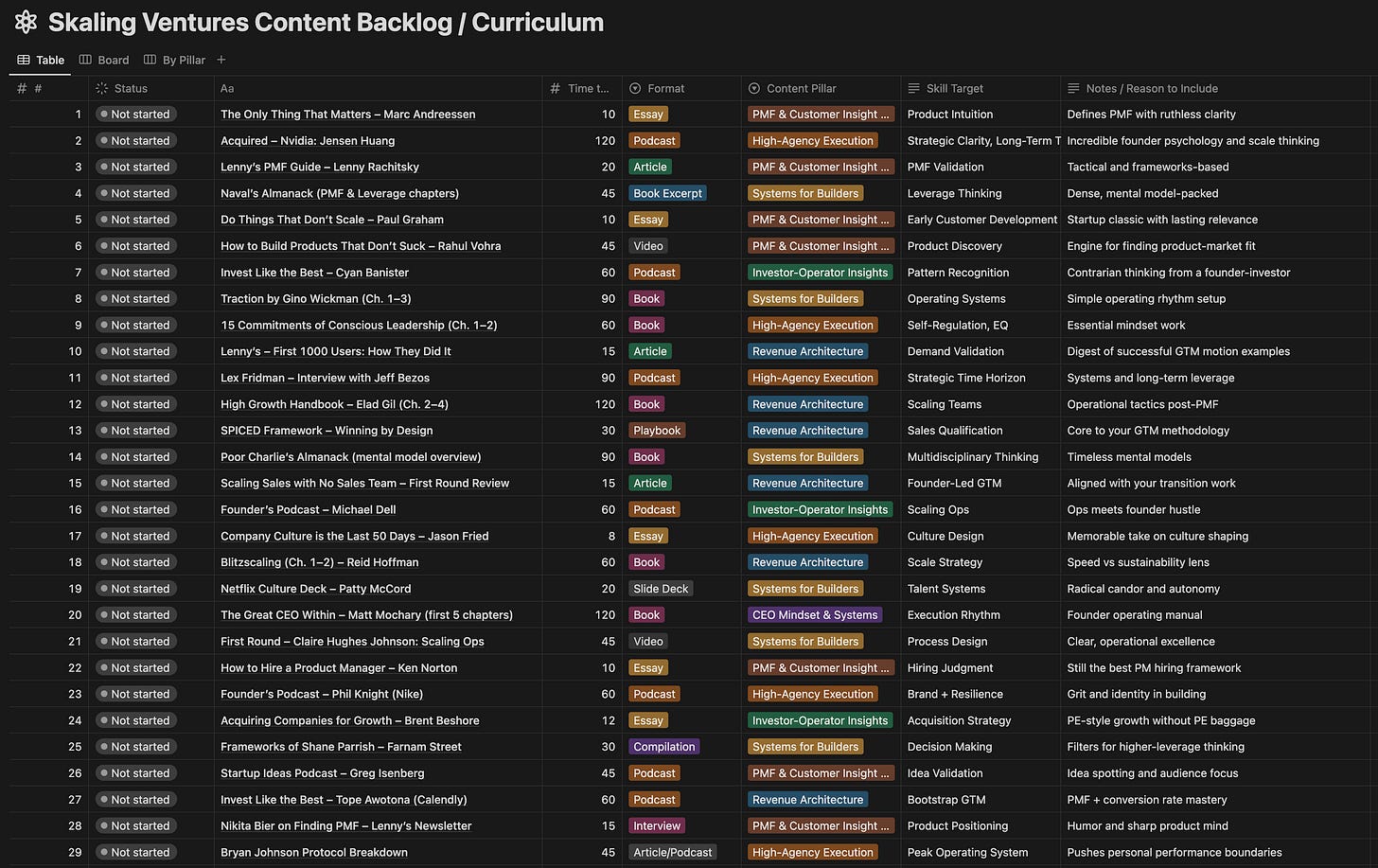🏴☠️ ⚡️ The Skaling Ventures Learning Curriculum: 100x High-Signal Resources to Sharpen Your Edge & The System to Develop Your Own
Join us every Saturday morning for value creation playbooks, operating concepts, deal analysis and diligence frameworks, and more...
TABLE OF CONTENTS:
Step 1: Define the Skills You Want to Build / Stack
Step 2: Organize Around Strategic Pillars
Step 3: Curate a High-Signal Content Backlog (Here’s Mine)
Step 4: Systematize Consumption
📺 WATCH:
📻 LISTEN:
Most people are overwhelmed by content. Very few treat it like a portfolio—curated, intentional, and aligned to their goals.
In a world drowning in essays, podcasts, newsletters, and tweet threads, it’s easy to feel productive while consuming—but end up nowhere strategically. I’ve felt it myself. Despite good intentions, my learning was scattered. So I rebuilt my entire approach.
I created a high-signal, skill-aligned content backlog—not to binge, but to compound. In this post, I’ll share exactly how I did it. You’ll get a look at the actual skills I’m focused on, the pillars I use to structure my learning, and the backlog I curated for the next number of months.
Whether you’re a founder, investor, or operator, you can adapt this system to fuel your own development.
Step 1: Define the Skills You Want to Build
Most people start with content formats. I started with skills. My guiding question:
What skills will future-me need to scale companies, deploy capital wisely, and lead with clarity?
Here’s a sample of the capabilities I prioritized:
Systems Thinking – to make better decisions with less data
Customer Discovery – to unlock real insight loops and build better GTM strategies
Capital Structuring – to allocate wisely and raise intelligently
Strategic Leadership – to drive outcomes with and through others
Energy Management – to sustain high-agency execution without burnout
These aren’t vague aspirations. They’re edge-sharpening investments—tools I expect to wield as both a CEO and investor for decades.
Step 2: Organize Around Strategic Pillars
Once I had the skills, I needed a framework to focus without becoming one-dimensional. That led to the creation of six content pillars:
Systems for Builders
High-Agency Execution
PMF & Customer Insight Loops
Revenue Architecture
Investor-Operator Insights
CEO Mindset & Systems
These pillars give me flexibility while keeping my learning anchored to what matters. They help me rotate between disciplines, identify patterns across domains, and stay sharp across my core operating arenas.
Step 3: Curate a High-Signal Content Backlog
With my skills and pillars in place, I let ChatGPT go to town on building a 100 item back-log of timeless, high-signal resources—essays, podcasts, book excerpts, and investor memos.
My criteria:
Timeless > trendy
Signal > noise
Depth + variety (short-form for velocity, long-form for clarity)
Tactical + strategic for real-world application
Each entry is mapped to a pillar, has an expected time-to-consume, and includes a note on why it matters.
👉 YOU CAN ACCESS THE FULL SKALING VENTURES CONTENT BACKLOG / CURRICULUM HERE
💡 Copy, remix, or steal anything that serves your development.
🧠 Better yet—define your own skills and start building your own learning system.
Treat your content diet like your investment portfolio: a few high-conviction bets, held for the long term.
Step 4: Create a Lightweight System for Consumption
I didn’t want another task list. I wanted a rhythm. So I built a low-friction system around these principles:
Weekly variety — 1 podcast, 1 article, 1 book excerpt
Quarterly theme — each quarter, I emphasize 1 pillar (e.g., Q2 = PMF & Insight Loops)
No pressure to finish — it's about progress and compounding, not consumption quotas
Light journaling — capture takeaways in Notion or a doc, nothing fancy
Learning is not about volume. It’s about compounding signal. Seeing more. Connecting faster. Deciding better.
Why This Matters
Intentional learning creates strategic separation.
We don’t just lead companies—we steer them through uncertainty. And the quality of your mental models, the speed of your insight loops, the structure of your judgment... they all compound.
This system isn’t about binge-learning. It’s about building a sharper operating system—one idea, one connection, one insight at a time.
Hit REPLY and let me know what you found most useful this week (or rock the one-question survey below) — truly eager to hear from you…
And please forward this email to whoever might benefit (or use the link below) 🏴☠️ ⚡️




